HLSC122: Critical Appraisal of Stroke Rehabilitation Evidence (2018)
VerifiedAdded on 2023/06/11
|8
|2196
|336
Report
AI Summary
This report presents a critical appraisal of research concerning stroke rehabilitation, specifically focusing on the combined perceptions of stroke patients and their caregivers regarding rehabilitation needs one year post-stroke. The appraisal assesses the strengths and weaknesses of a research study employing mixed methods to investigate the relationship between rehabilitation needs, stroke severity, individual factors, and caregiver burden. It examines the study's authorship, research questions, design, methods, and results, highlighting the importance of a dyadic perspective in understanding and addressing rehabilitation needs. The report concludes that integrating caregivers into rehabilitation systems can improve outcomes and emphasizes the need for further research in this area, while also aligning the study's findings with existing literature and acknowledging its limitations.
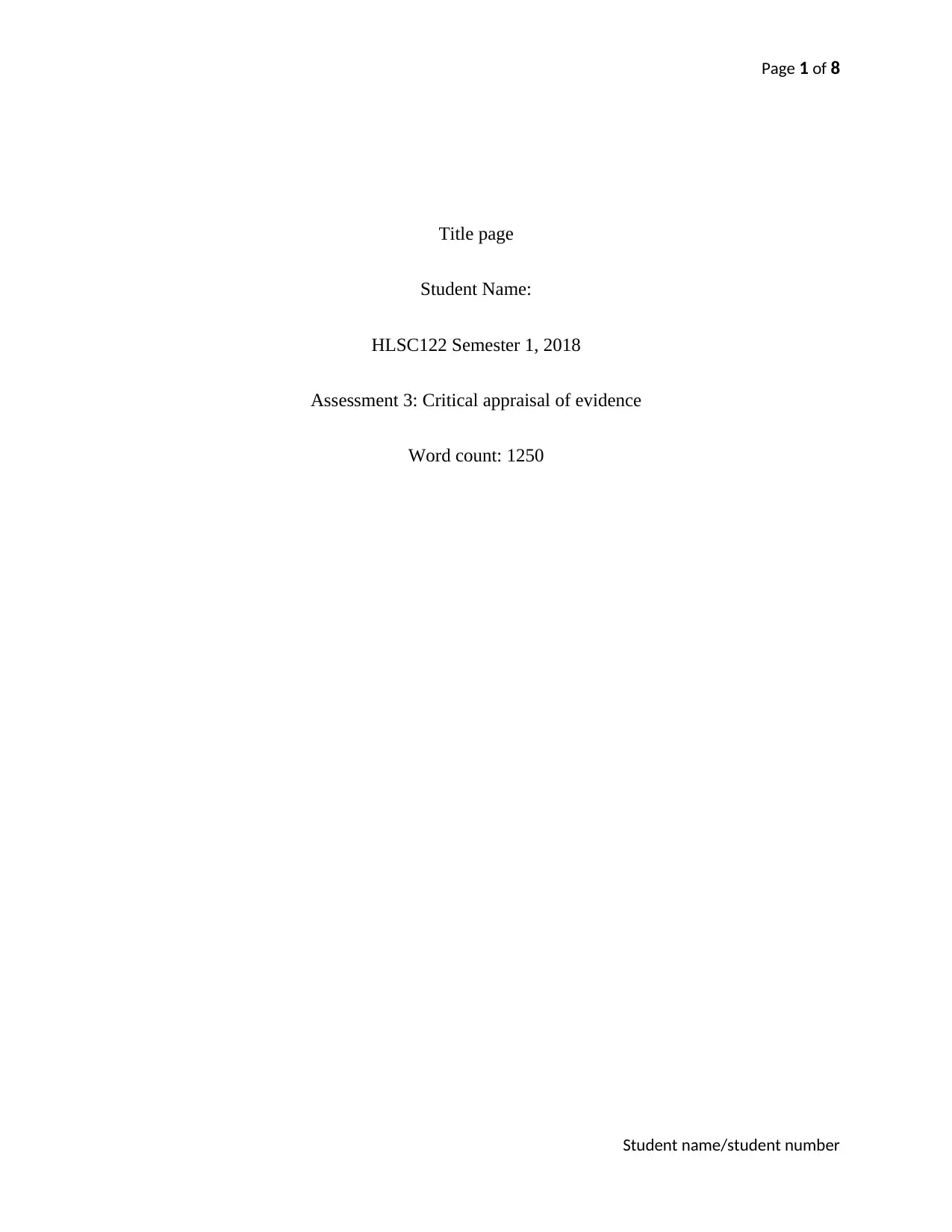
Page 1 of 8
Title page
Student Name:
HLSC122 Semester 1, 2018
Assessment 3: Critical appraisal of evidence
Word count: 1250
Student name/student number
Title page
Student Name:
HLSC122 Semester 1, 2018
Assessment 3: Critical appraisal of evidence
Word count: 1250
Student name/student number
Paraphrase This Document
Need a fresh take? Get an instant paraphrase of this document with our AI Paraphraser
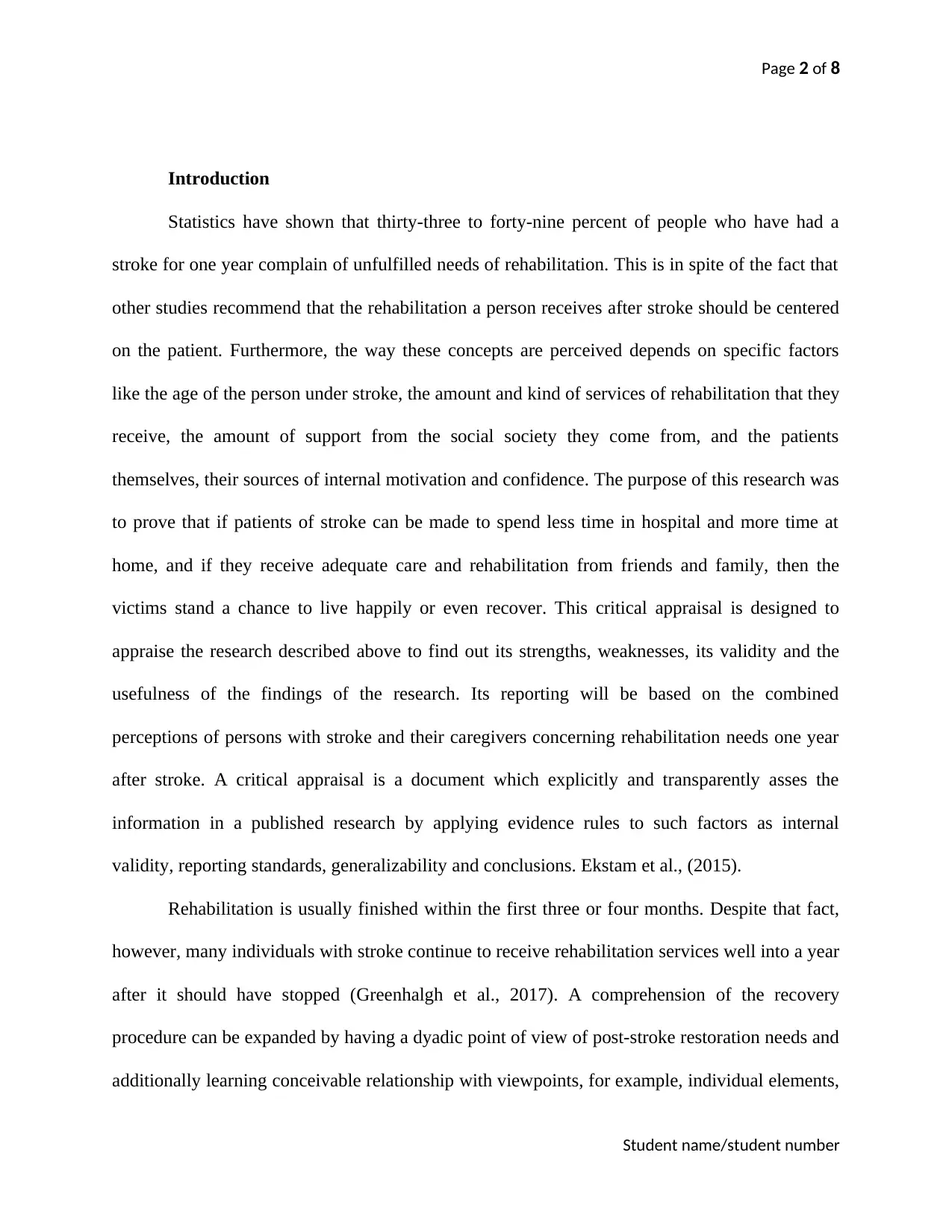
Page 2 of 8
Introduction
Statistics have shown that thirty-three to forty-nine percent of people who have had a
stroke for one year complain of unfulfilled needs of rehabilitation. This is in spite of the fact that
other studies recommend that the rehabilitation a person receives after stroke should be centered
on the patient. Furthermore, the way these concepts are perceived depends on specific factors
like the age of the person under stroke, the amount and kind of services of rehabilitation that they
receive, the amount of support from the social society they come from, and the patients
themselves, their sources of internal motivation and confidence. The purpose of this research was
to prove that if patients of stroke can be made to spend less time in hospital and more time at
home, and if they receive adequate care and rehabilitation from friends and family, then the
victims stand a chance to live happily or even recover. This critical appraisal is designed to
appraise the research described above to find out its strengths, weaknesses, its validity and the
usefulness of the findings of the research. Its reporting will be based on the combined
perceptions of persons with stroke and their caregivers concerning rehabilitation needs one year
after stroke. A critical appraisal is a document which explicitly and transparently asses the
information in a published research by applying evidence rules to such factors as internal
validity, reporting standards, generalizability and conclusions. Ekstam et al., (2015).
Rehabilitation is usually finished within the first three or four months. Despite that fact,
however, many individuals with stroke continue to receive rehabilitation services well into a year
after it should have stopped (Greenhalgh et al., 2017). A comprehension of the recovery
procedure can be expanded by having a dyadic point of view of post-stroke restoration needs and
additionally learning conceivable relationship with viewpoints, for example, individual elements,
Student name/student number
Introduction
Statistics have shown that thirty-three to forty-nine percent of people who have had a
stroke for one year complain of unfulfilled needs of rehabilitation. This is in spite of the fact that
other studies recommend that the rehabilitation a person receives after stroke should be centered
on the patient. Furthermore, the way these concepts are perceived depends on specific factors
like the age of the person under stroke, the amount and kind of services of rehabilitation that they
receive, the amount of support from the social society they come from, and the patients
themselves, their sources of internal motivation and confidence. The purpose of this research was
to prove that if patients of stroke can be made to spend less time in hospital and more time at
home, and if they receive adequate care and rehabilitation from friends and family, then the
victims stand a chance to live happily or even recover. This critical appraisal is designed to
appraise the research described above to find out its strengths, weaknesses, its validity and the
usefulness of the findings of the research. Its reporting will be based on the combined
perceptions of persons with stroke and their caregivers concerning rehabilitation needs one year
after stroke. A critical appraisal is a document which explicitly and transparently asses the
information in a published research by applying evidence rules to such factors as internal
validity, reporting standards, generalizability and conclusions. Ekstam et al., (2015).
Rehabilitation is usually finished within the first three or four months. Despite that fact,
however, many individuals with stroke continue to receive rehabilitation services well into a year
after it should have stopped (Greenhalgh et al., 2017). A comprehension of the recovery
procedure can be expanded by having a dyadic point of view of post-stroke restoration needs and
additionally learning conceivable relationship with viewpoints, for example, individual elements,
Student name/student number
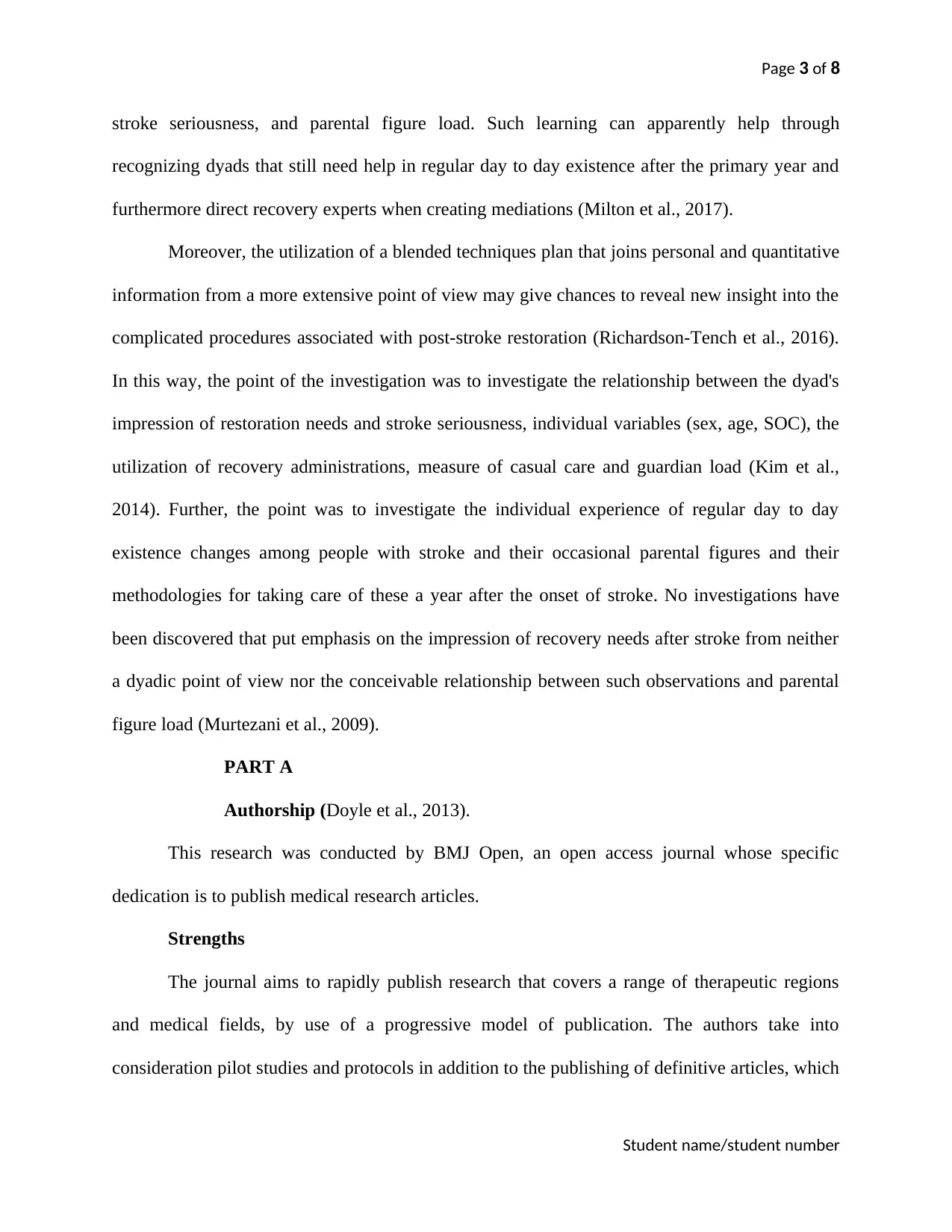
Page 3 of 8
stroke seriousness, and parental figure load. Such learning can apparently help through
recognizing dyads that still need help in regular day to day existence after the primary year and
furthermore direct recovery experts when creating mediations (Milton et al., 2017).
Moreover, the utilization of a blended techniques plan that joins personal and quantitative
information from a more extensive point of view may give chances to reveal new insight into the
complicated procedures associated with post-stroke restoration (Richardson-Tench et al., 2016).
In this way, the point of the investigation was to investigate the relationship between the dyad's
impression of restoration needs and stroke seriousness, individual variables (sex, age, SOC), the
utilization of recovery administrations, measure of casual care and guardian load (Kim et al.,
2014). Further, the point was to investigate the individual experience of regular day to day
existence changes among people with stroke and their occasional parental figures and their
methodologies for taking care of these a year after the onset of stroke. No investigations have
been discovered that put emphasis on the impression of recovery needs after stroke from neither
a dyadic point of view nor the conceivable relationship between such observations and parental
figure load (Murtezani et al., 2009).
PART A
Authorship (Doyle et al., 2013).
This research was conducted by BMJ Open, an open access journal whose specific
dedication is to publish medical research articles.
Strengths
The journal aims to rapidly publish research that covers a range of therapeutic regions
and medical fields, by use of a progressive model of publication. The authors take into
consideration pilot studies and protocols in addition to the publishing of definitive articles, which
Student name/student number
stroke seriousness, and parental figure load. Such learning can apparently help through
recognizing dyads that still need help in regular day to day existence after the primary year and
furthermore direct recovery experts when creating mediations (Milton et al., 2017).
Moreover, the utilization of a blended techniques plan that joins personal and quantitative
information from a more extensive point of view may give chances to reveal new insight into the
complicated procedures associated with post-stroke restoration (Richardson-Tench et al., 2016).
In this way, the point of the investigation was to investigate the relationship between the dyad's
impression of restoration needs and stroke seriousness, individual variables (sex, age, SOC), the
utilization of recovery administrations, measure of casual care and guardian load (Kim et al.,
2014). Further, the point was to investigate the individual experience of regular day to day
existence changes among people with stroke and their occasional parental figures and their
methodologies for taking care of these a year after the onset of stroke. No investigations have
been discovered that put emphasis on the impression of recovery needs after stroke from neither
a dyadic point of view nor the conceivable relationship between such observations and parental
figure load (Murtezani et al., 2009).
PART A
Authorship (Doyle et al., 2013).
This research was conducted by BMJ Open, an open access journal whose specific
dedication is to publish medical research articles.
Strengths
The journal aims to rapidly publish research that covers a range of therapeutic regions
and medical fields, by use of a progressive model of publication. The authors take into
consideration pilot studies and protocols in addition to the publishing of definitive articles, which
Student name/student number
⊘ This is a preview!⊘
Do you want full access?
Subscribe today to unlock all pages.

Trusted by 1+ million students worldwide
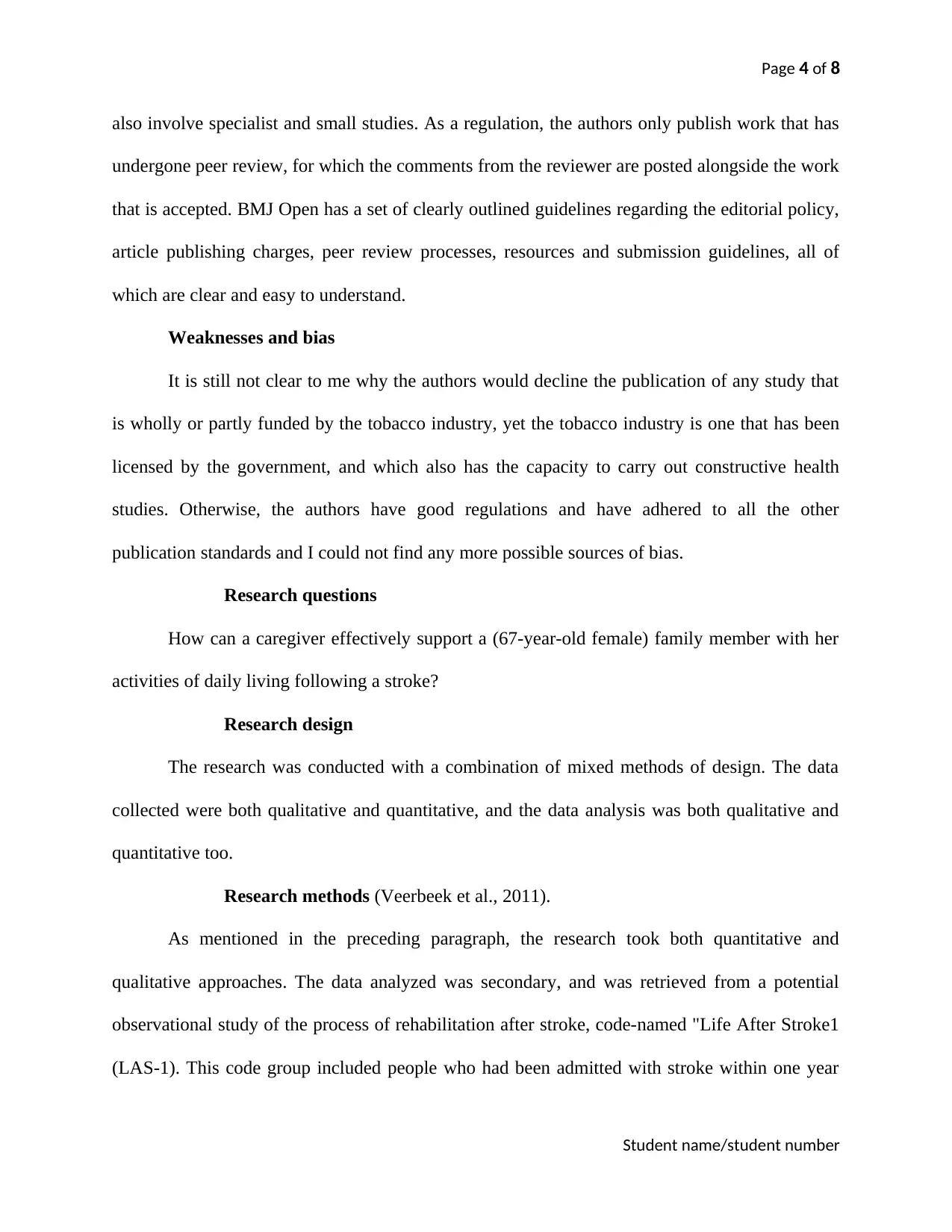
Page 4 of 8
also involve specialist and small studies. As a regulation, the authors only publish work that has
undergone peer review, for which the comments from the reviewer are posted alongside the work
that is accepted. BMJ Open has a set of clearly outlined guidelines regarding the editorial policy,
article publishing charges, peer review processes, resources and submission guidelines, all of
which are clear and easy to understand.
Weaknesses and bias
It is still not clear to me why the authors would decline the publication of any study that
is wholly or partly funded by the tobacco industry, yet the tobacco industry is one that has been
licensed by the government, and which also has the capacity to carry out constructive health
studies. Otherwise, the authors have good regulations and have adhered to all the other
publication standards and I could not find any more possible sources of bias.
Research questions
How can a caregiver effectively support a (67-year-old female) family member with her
activities of daily living following a stroke?
Research design
The research was conducted with a combination of mixed methods of design. The data
collected were both qualitative and quantitative, and the data analysis was both qualitative and
quantitative too.
Research methods (Veerbeek et al., 2011).
As mentioned in the preceding paragraph, the research took both quantitative and
qualitative approaches. The data analyzed was secondary, and was retrieved from a potential
observational study of the process of rehabilitation after stroke, code-named "Life After Stroke1
(LAS-1). This code group included people who had been admitted with stroke within one year
Student name/student number
also involve specialist and small studies. As a regulation, the authors only publish work that has
undergone peer review, for which the comments from the reviewer are posted alongside the work
that is accepted. BMJ Open has a set of clearly outlined guidelines regarding the editorial policy,
article publishing charges, peer review processes, resources and submission guidelines, all of
which are clear and easy to understand.
Weaknesses and bias
It is still not clear to me why the authors would decline the publication of any study that
is wholly or partly funded by the tobacco industry, yet the tobacco industry is one that has been
licensed by the government, and which also has the capacity to carry out constructive health
studies. Otherwise, the authors have good regulations and have adhered to all the other
publication standards and I could not find any more possible sources of bias.
Research questions
How can a caregiver effectively support a (67-year-old female) family member with her
activities of daily living following a stroke?
Research design
The research was conducted with a combination of mixed methods of design. The data
collected were both qualitative and quantitative, and the data analysis was both qualitative and
quantitative too.
Research methods (Veerbeek et al., 2011).
As mentioned in the preceding paragraph, the research took both quantitative and
qualitative approaches. The data analyzed was secondary, and was retrieved from a potential
observational study of the process of rehabilitation after stroke, code-named "Life After Stroke1
(LAS-1). This code group included people who had been admitted with stroke within one year
Student name/student number
Paraphrase This Document
Need a fresh take? Get an instant paraphrase of this document with our AI Paraphraser
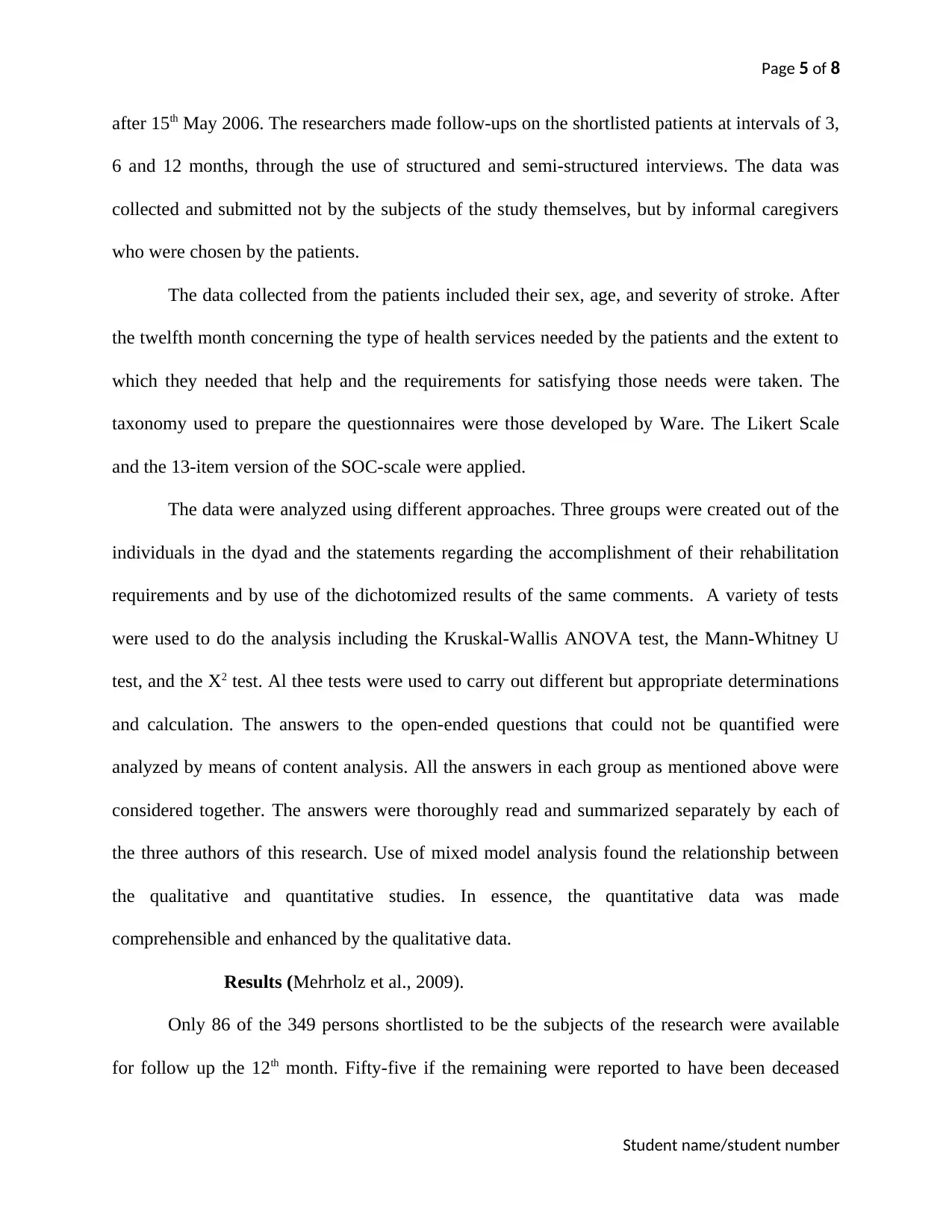
Page 5 of 8
after 15th May 2006. The researchers made follow-ups on the shortlisted patients at intervals of 3,
6 and 12 months, through the use of structured and semi-structured interviews. The data was
collected and submitted not by the subjects of the study themselves, but by informal caregivers
who were chosen by the patients.
The data collected from the patients included their sex, age, and severity of stroke. After
the twelfth month concerning the type of health services needed by the patients and the extent to
which they needed that help and the requirements for satisfying those needs were taken. The
taxonomy used to prepare the questionnaires were those developed by Ware. The Likert Scale
and the 13-item version of the SOC-scale were applied.
The data were analyzed using different approaches. Three groups were created out of the
individuals in the dyad and the statements regarding the accomplishment of their rehabilitation
requirements and by use of the dichotomized results of the same comments. A variety of tests
were used to do the analysis including the Kruskal-Wallis ANOVA test, the Mann-Whitney U
test, and the X2 test. Al thee tests were used to carry out different but appropriate determinations
and calculation. The answers to the open-ended questions that could not be quantified were
analyzed by means of content analysis. All the answers in each group as mentioned above were
considered together. The answers were thoroughly read and summarized separately by each of
the three authors of this research. Use of mixed model analysis found the relationship between
the qualitative and quantitative studies. In essence, the quantitative data was made
comprehensible and enhanced by the qualitative data.
Results (Mehrholz et al., 2009).
Only 86 of the 349 persons shortlisted to be the subjects of the research were available
for follow up the 12th month. Fifty-five if the remaining were reported to have been deceased
Student name/student number
after 15th May 2006. The researchers made follow-ups on the shortlisted patients at intervals of 3,
6 and 12 months, through the use of structured and semi-structured interviews. The data was
collected and submitted not by the subjects of the study themselves, but by informal caregivers
who were chosen by the patients.
The data collected from the patients included their sex, age, and severity of stroke. After
the twelfth month concerning the type of health services needed by the patients and the extent to
which they needed that help and the requirements for satisfying those needs were taken. The
taxonomy used to prepare the questionnaires were those developed by Ware. The Likert Scale
and the 13-item version of the SOC-scale were applied.
The data were analyzed using different approaches. Three groups were created out of the
individuals in the dyad and the statements regarding the accomplishment of their rehabilitation
requirements and by use of the dichotomized results of the same comments. A variety of tests
were used to do the analysis including the Kruskal-Wallis ANOVA test, the Mann-Whitney U
test, and the X2 test. Al thee tests were used to carry out different but appropriate determinations
and calculation. The answers to the open-ended questions that could not be quantified were
analyzed by means of content analysis. All the answers in each group as mentioned above were
considered together. The answers were thoroughly read and summarized separately by each of
the three authors of this research. Use of mixed model analysis found the relationship between
the qualitative and quantitative studies. In essence, the quantitative data was made
comprehensible and enhanced by the qualitative data.
Results (Mehrholz et al., 2009).
Only 86 of the 349 persons shortlisted to be the subjects of the research were available
for follow up the 12th month. Fifty-five if the remaining were reported to have been deceased
Student name/student number

Page 6 of 8
within a year after stroke. One hundred and seventeen of the remaining had not been able to gain
access to any known caregivers; 15 participated but did not answer the ultimate research
question, and the remaining seventy refused to be followed up. Some of the results collected
were presented in tables. For example, the tributes of the person suffering from stroke, the
amount of medical care they received and the extent of informal responsibility and the burden
they imposed on caregivers were recorded in table form. In summary, however, the following are
the findings that came out of the research: the severity of stroke was related to the needs of
dyad’s rehabilitation ; the methods used by the person with stroke to overcome daily challenges
determined the dyad’s rehabilitation needs; in cases where the rehabilitation needs were met, the
caregivers saw fewer burdens in the dyads.
More in-depth explanations for the results highlighted above can be found in the research report
at the authors' website.
PART B
Conclusion (Kvist, 2010)
The results of the study were found to be in line with those of other studies done in the
past. The past studies, however, did not employ the approach of studying both the person with
stroke and the caregiver at the same time. Instead, the two were examined separately. It was
realized that the research problem could be mitigated easily and faster if the caregivers and other
individuals who play a role in the rehabilitation systems are integrated. Rehabilitation
professionals can be guided during the provision of interventions, and our understanding of the
perspective can be enhanced if we strive to gain a dyadic perspective of how the aspects
documented in this appraisal are related to rehabilitation needs. Nevertheless, there is still need
to do more research on the effects using rehabilitation to gain a dyadic perspective.
Student name/student number
within a year after stroke. One hundred and seventeen of the remaining had not been able to gain
access to any known caregivers; 15 participated but did not answer the ultimate research
question, and the remaining seventy refused to be followed up. Some of the results collected
were presented in tables. For example, the tributes of the person suffering from stroke, the
amount of medical care they received and the extent of informal responsibility and the burden
they imposed on caregivers were recorded in table form. In summary, however, the following are
the findings that came out of the research: the severity of stroke was related to the needs of
dyad’s rehabilitation ; the methods used by the person with stroke to overcome daily challenges
determined the dyad’s rehabilitation needs; in cases where the rehabilitation needs were met, the
caregivers saw fewer burdens in the dyads.
More in-depth explanations for the results highlighted above can be found in the research report
at the authors' website.
PART B
Conclusion (Kvist, 2010)
The results of the study were found to be in line with those of other studies done in the
past. The past studies, however, did not employ the approach of studying both the person with
stroke and the caregiver at the same time. Instead, the two were examined separately. It was
realized that the research problem could be mitigated easily and faster if the caregivers and other
individuals who play a role in the rehabilitation systems are integrated. Rehabilitation
professionals can be guided during the provision of interventions, and our understanding of the
perspective can be enhanced if we strive to gain a dyadic perspective of how the aspects
documented in this appraisal are related to rehabilitation needs. Nevertheless, there is still need
to do more research on the effects using rehabilitation to gain a dyadic perspective.
Student name/student number
⊘ This is a preview!⊘
Do you want full access?
Subscribe today to unlock all pages.

Trusted by 1+ million students worldwide
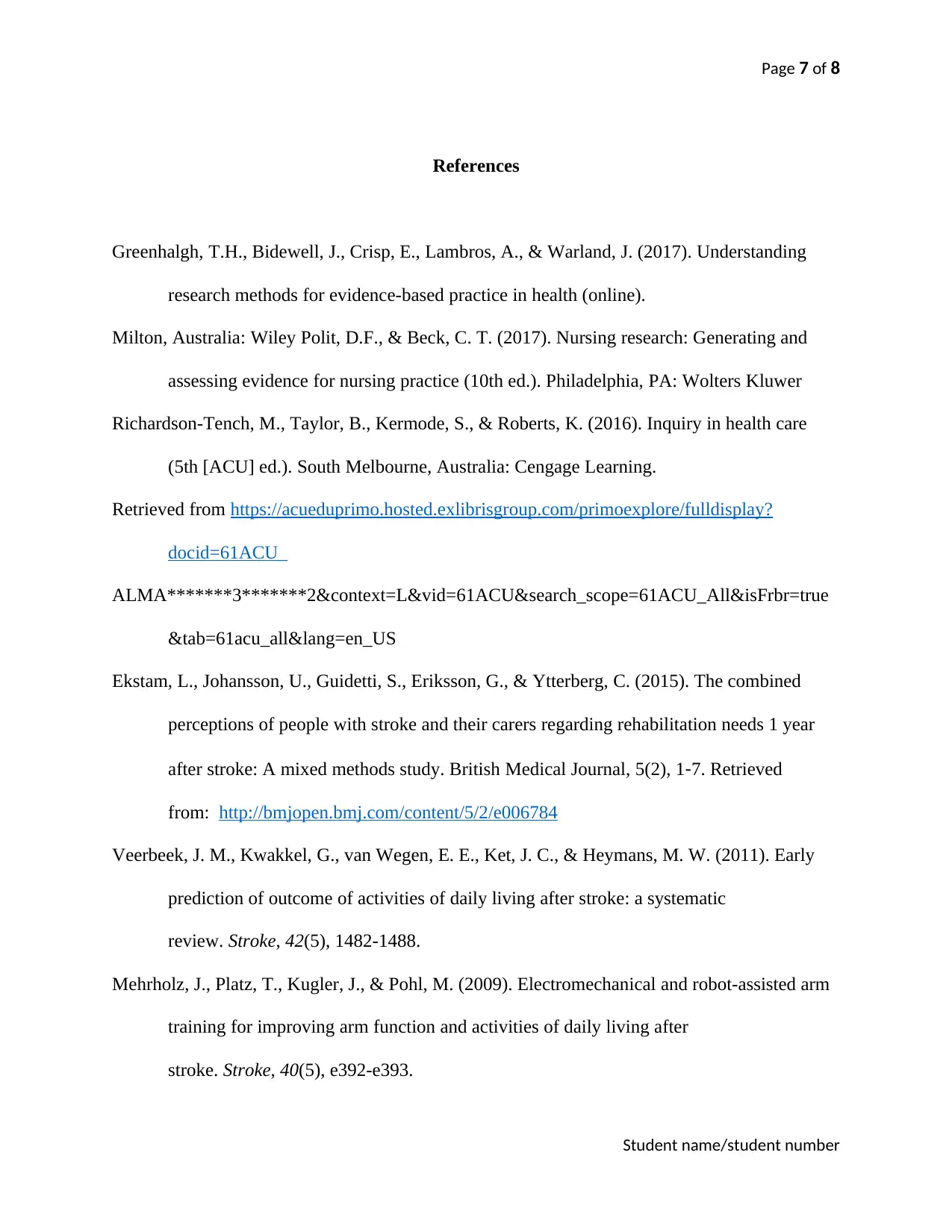
Page 7 of 8
References
Greenhalgh, T.H., Bidewell, J., Crisp, E., Lambros, A., & Warland, J. (2017). Understanding
research methods for evidence-based practice in health (online).
Milton, Australia: Wiley Polit, D.F., & Beck, C. T. (2017). Nursing research: Generating and
assessing evidence for nursing practice (10th ed.). Philadelphia, PA: Wolters Kluwer
Richardson-Tench, M., Taylor, B., Kermode, S., & Roberts, K. (2016). Inquiry in health care
(5th [ACU] ed.). South Melbourne, Australia: Cengage Learning.
Retrieved from https://acueduprimo.hosted.exlibrisgroup.com/primoexplore/fulldisplay?
docid=61ACU_
ALMA*******3*******2&context=L&vid=61ACU&search_scope=61ACU_All&isFrbr=true
&tab=61acu_all&lang=en_US
Ekstam, L., Johansson, U., Guidetti, S., Eriksson, G., & Ytterberg, C. (2015). The combined
perceptions of people with stroke and their carers regarding rehabilitation needs 1 year
after stroke: A mixed methods study. British Medical Journal, 5(2), 1‐7. Retrieved
from: http://bmjopen.bmj.com/content/5/2/e006784
Veerbeek, J. M., Kwakkel, G., van Wegen, E. E., Ket, J. C., & Heymans, M. W. (2011). Early
prediction of outcome of activities of daily living after stroke: a systematic
review. Stroke, 42(5), 1482-1488.
Mehrholz, J., Platz, T., Kugler, J., & Pohl, M. (2009). Electromechanical and robot-assisted arm
training for improving arm function and activities of daily living after
stroke. Stroke, 40(5), e392-e393.
Student name/student number
References
Greenhalgh, T.H., Bidewell, J., Crisp, E., Lambros, A., & Warland, J. (2017). Understanding
research methods for evidence-based practice in health (online).
Milton, Australia: Wiley Polit, D.F., & Beck, C. T. (2017). Nursing research: Generating and
assessing evidence for nursing practice (10th ed.). Philadelphia, PA: Wolters Kluwer
Richardson-Tench, M., Taylor, B., Kermode, S., & Roberts, K. (2016). Inquiry in health care
(5th [ACU] ed.). South Melbourne, Australia: Cengage Learning.
Retrieved from https://acueduprimo.hosted.exlibrisgroup.com/primoexplore/fulldisplay?
docid=61ACU_
ALMA*******3*******2&context=L&vid=61ACU&search_scope=61ACU_All&isFrbr=true
&tab=61acu_all&lang=en_US
Ekstam, L., Johansson, U., Guidetti, S., Eriksson, G., & Ytterberg, C. (2015). The combined
perceptions of people with stroke and their carers regarding rehabilitation needs 1 year
after stroke: A mixed methods study. British Medical Journal, 5(2), 1‐7. Retrieved
from: http://bmjopen.bmj.com/content/5/2/e006784
Veerbeek, J. M., Kwakkel, G., van Wegen, E. E., Ket, J. C., & Heymans, M. W. (2011). Early
prediction of outcome of activities of daily living after stroke: a systematic
review. Stroke, 42(5), 1482-1488.
Mehrholz, J., Platz, T., Kugler, J., & Pohl, M. (2009). Electromechanical and robot-assisted arm
training for improving arm function and activities of daily living after
stroke. Stroke, 40(5), e392-e393.
Student name/student number
Paraphrase This Document
Need a fresh take? Get an instant paraphrase of this document with our AI Paraphraser
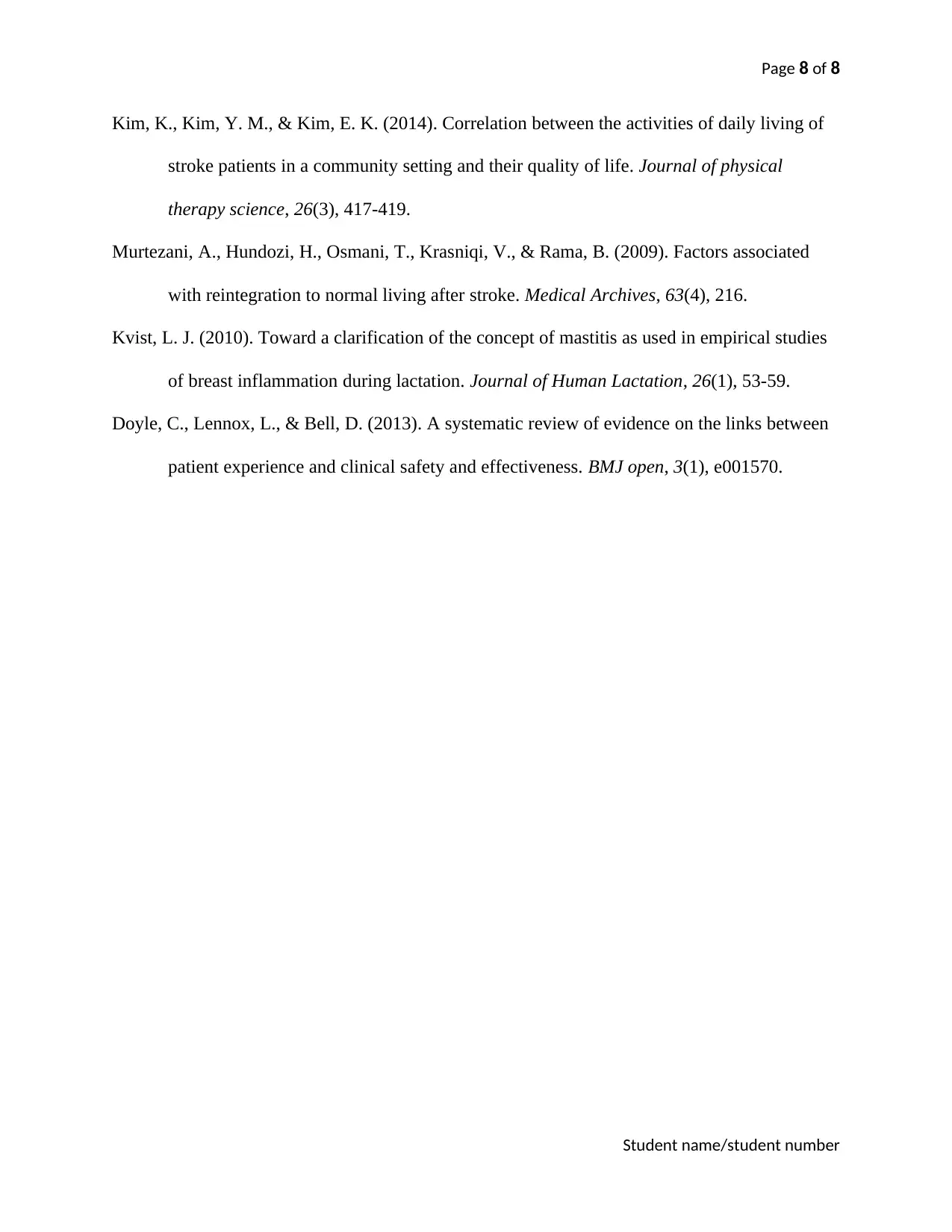
Page 8 of 8
Kim, K., Kim, Y. M., & Kim, E. K. (2014). Correlation between the activities of daily living of
stroke patients in a community setting and their quality of life. Journal of physical
therapy science, 26(3), 417-419.
Murtezani, A., Hundozi, H., Osmani, T., Krasniqi, V., & Rama, B. (2009). Factors associated
with reintegration to normal living after stroke. Medical Archives, 63(4), 216.
Kvist, L. J. (2010). Toward a clarification of the concept of mastitis as used in empirical studies
of breast inflammation during lactation. Journal of Human Lactation, 26(1), 53-59.
Doyle, C., Lennox, L., & Bell, D. (2013). A systematic review of evidence on the links between
patient experience and clinical safety and effectiveness. BMJ open, 3(1), e001570.
Student name/student number
Kim, K., Kim, Y. M., & Kim, E. K. (2014). Correlation between the activities of daily living of
stroke patients in a community setting and their quality of life. Journal of physical
therapy science, 26(3), 417-419.
Murtezani, A., Hundozi, H., Osmani, T., Krasniqi, V., & Rama, B. (2009). Factors associated
with reintegration to normal living after stroke. Medical Archives, 63(4), 216.
Kvist, L. J. (2010). Toward a clarification of the concept of mastitis as used in empirical studies
of breast inflammation during lactation. Journal of Human Lactation, 26(1), 53-59.
Doyle, C., Lennox, L., & Bell, D. (2013). A systematic review of evidence on the links between
patient experience and clinical safety and effectiveness. BMJ open, 3(1), e001570.
Student name/student number
1 out of 8
Related Documents
Your All-in-One AI-Powered Toolkit for Academic Success.
+13062052269
info@desklib.com
Available 24*7 on WhatsApp / Email
![[object Object]](/_next/static/media/star-bottom.7253800d.svg)
Unlock your academic potential
Copyright © 2020–2025 A2Z Services. All Rights Reserved. Developed and managed by ZUCOL.




